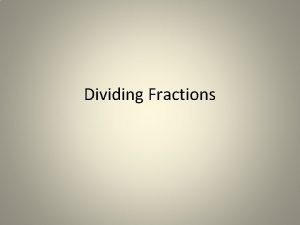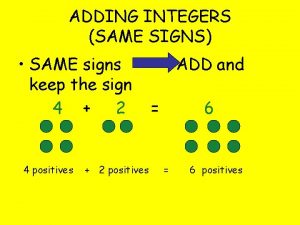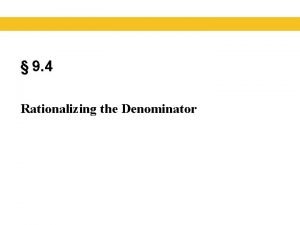Adding Fractions Adding Fractions The same denominator NOTES








- Slides: 8

Adding Fractions

Adding Fractions – The same denominator NOTES **IF the denominators are already the same you can start adding right away! The denominators NEED to be the same It needs to be the same size piece for you to know how much you have! Add 1 4 + 1 4 = 2 4 STEPS 1. Add the numerators 1+1=2 2. Keep the denominator the same. Denominator stays 4 (The size of the piece doesn’t change!)

Adding Fractions – Different denominators Add STEP 1 – Equivalent Fractions 1 2 = 2 4 STEP 2 – Add the Numerators 2 + 1 4 4 2+1=3 STEP 3 – Keep the Demoninator 2 + 1 4 4 4 remains the same 1 2 = + NOTES The denominators are different. 1 4 3 4 The denominators NEED to be the same It needs to be the same size piece for you to know how much you have! STEPS 1. Create equivalent fractions 2. Add the numerators 2+1=3 3. Keep the denominator the same Denominator stays 4 (The size of the piece doesn’t change!)

Adding Fractions – Different denominators. Example 2 Remember: The pieces have the be the same size (denominators the same) in order to be able to add or subtract fractions! = 17 12 Step 1: Find the new denominator • Find a common multiple of both the denominators. • If you cannot find anything smaller, you can ALWAYS just multiply the denominators together and you will find a multiple of both numbers. • This may not result in the LOWEST common multiple – you may have to reduce the fraction at the end. • 3 and 4 are both factors of 12 • 12 is a multiple of 3 and 4 Step 2: Find the new numerators • Whatever you did to the denominator, you must multiply/divide the numerator by the SAME number to keep the fractions equivalent. Step 3: Add the numerators • The denominator stays the same as you found in step 1. The size of the piece doesn’t’ change!

Subtracting Fractions

Subtracting Fractions – The same denominator NOTES **IF the denominators are already the same you can start subtracting right away! The denominators NEED to be the same It needs to be the same size piece for you to know how much you have! Subtract 3 4 - 1 4 = 2 4 STEPS 1. Subtract the numerators. 3 -1=2 2. Keep the denominator the same. Denominator stays 4 (The size of the piece doesn’t change!)

Subtracting Fractions – Different denominators STEP 1 – Equivalent Fractions 1 2 = 2 4 STEP 2 – Subtract the Numerators 2 - 1 4 4 2 -1=1 STEP 3 – Keep the Demoninator 2 - 1 4 4 2+1=1 Subtract 1 2 - 1 = 4 1 4 NOTES The denominators are different. The denominators NEED to be the same It needs to be the same size piece for you to know how much you have! STEPS 1. Create equivalent fractions 2. Subtract the numerators 2 -1=1 3. Keep the denominator the same Denominator stays 4 (The size of the piece doesn’t change!)

Subtracting Fractions – Different denominators. Example 2 Step 1: Find the new denominator • Find a common multiple of both the denominators. • If you cannot find anything smaller, you Steps 1 and 2 are the can ALWAYS just multiply the same as when you added denominators together and you will find a multiple of both numbers. fractions! • This may not result in the LOWEST common multiple – you may have to reduce the fraction at the end. • 4 and 5 are both factors of 20 • 20 is a multiple of 4 and 5 Step 2: Find the new numerators • Whatever you did to the denominator, you must multiply/divide the numerator by the SAME number to keep the fractions equivalent. Step 3: Subtract the numerators • The denominator stays the same as you found in step 1. The size of the piece doesn’t’ change!















